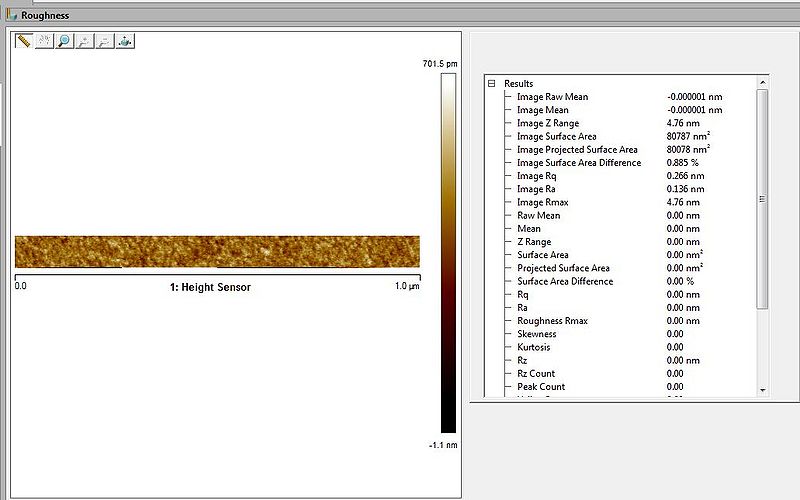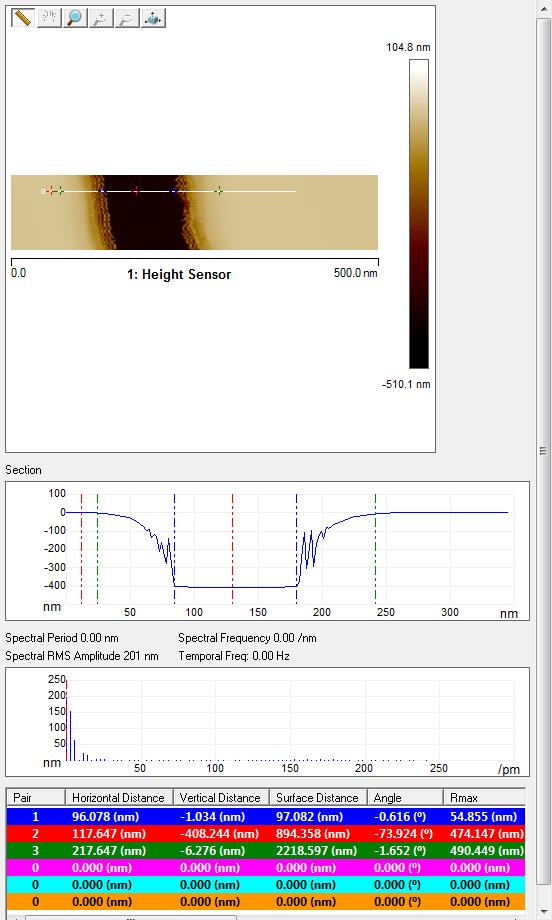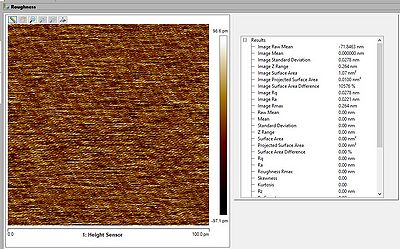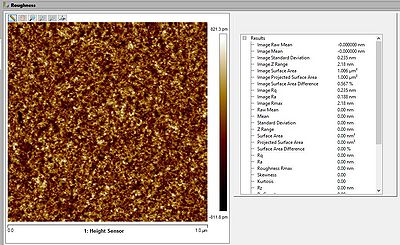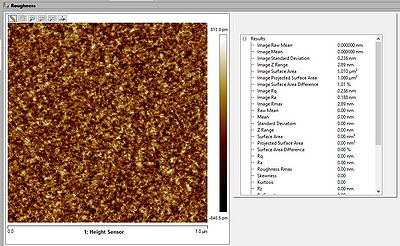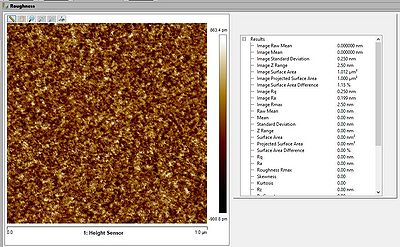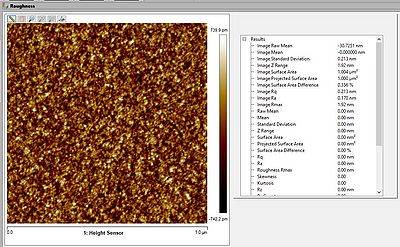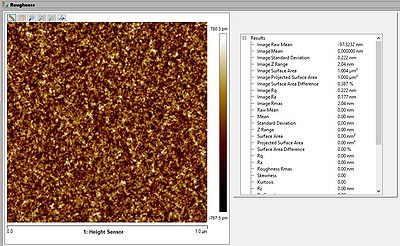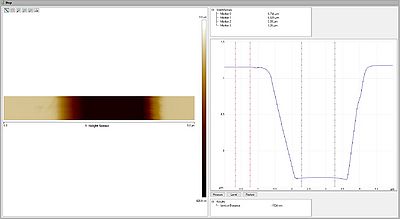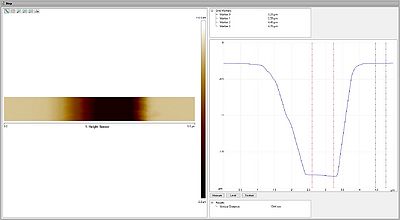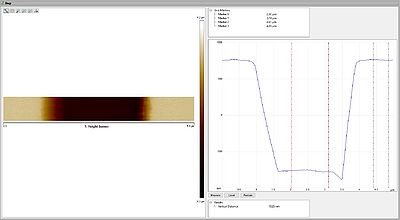Specific Process Knowledge/Characterization/AFM: Atomic Force Microscopy/AFM Icon Acceptance: Difference between revisions
No edit summary |
|||
| (44 intermediate revisions by the same user not shown) | |||
| Line 1: | Line 1: | ||
'''Feedback to this page''': '''[mailto:labadviser@danchip.dtu.dk?Subject=Feed%20back%20from%20page%20http://labadviser.danchip.dtu.dk/index.php/Specific_Process_Knowledge/Characterization/AFM:_Atomic_Force_Microscopy/AFM_Icon_Acceptance click here]''' | '''Feedback to this page''': '''[mailto:labadviser@danchip.dtu.dk?Subject=Feed%20back%20from%20page%20http://labadviser.danchip.dtu.dk/index.php/Specific_Process_Knowledge/Characterization/AFM:_Atomic_Force_Microscopy/AFM_Icon_Acceptance click here]''' | ||
==Accessories following the systems | ''This page has been made by Berit Herstrøm @ DTU Nanolab'' | ||
{| border="2" cellspacing="0" cellpadding="2" | ==Accessories following the systems == | ||
{| border="2" cellspacing="0" cellpadding="2" valign="top" | |||
!border="none" style="background:silver; color:black;" align="center"|Equipment | !border="none" style="background:silver; color:black;" align="center"|Equipment | ||
|style="background:WhiteSmoke; color:black"|<b>AFM Icon</b> | |style="background:WhiteSmoke; color:black"|<b>AFM Icon</b> | ||
|style="background:WhiteSmoke; color:black"|<b>AFM Icon 2</b> | |style="background:WhiteSmoke; color:black"|<b>AFM Icon 2 </b> | ||
|- | |- | ||
| Line 13: | Line 14: | ||
*A symmetric chuck that handles up to 210mm wafers and 15mm thick | *A symmetric chuck that handles up to 210mm wafers and 15mm thick | ||
*An asymmetric chuck that handles up to ~4" wafer (but not small pieces) - using this a whole 4" can be accessed without rotating the sample. | *An asymmetric chuck that handles up to ~4" wafer (but not small pieces) - using this a whole 4" can be accessed without rotating the sample. | ||
|style="background:WhiteSmoke; color:black"| | |style="background:WhiteSmoke; color:black" valign="top"| | ||
*A symmetric chuck that handles up to 210mm wafers and 15mm thick | *A symmetric chuck that handles up to 210mm wafers and 15mm thick | ||
|- | |- | ||
| Line 27: | Line 28: | ||
!style="background:silver; color:black" align="left"|Modes included | !style="background:silver; color:black" align="left"|Modes included | ||
|style="background:WhiteSmoke; color:black"| | |style="background:WhiteSmoke; color:black"| | ||
*ScanAsyst | *PeakForce Tapping mode / ScanAsyst | ||
*TappingMode (air) | *TappingMode (air) | ||
*Contact Mode | *Contact Mode | ||
*Lateral Force Microscopy | *Lateral Force Microscopy | ||
* | *Phase Imaging | ||
*Lift mode | *Lift mode | ||
*MFM | *MFM | ||
| Line 49: | Line 50: | ||
*Microscope Image Registration and Overlay (MIRO) software. '''this is only working in the old software (before version 9.4)''' | *Microscope Image Registration and Overlay (MIRO) software. '''this is only working in the old software (before version 9.4)''' | ||
|style="background:WhiteSmoke; color:black"| | |style="background:WhiteSmoke; color:black" valign="top"| | ||
*ScanAsyst | *PeakForce Tapping mode / ScanAsyst | ||
*TappingMode (air) | *TappingMode (air) | ||
*Contact Mode | *Contact Mode | ||
*Lateral Force Microscopy | *Lateral Force Microscopy | ||
* | *Phase Imaging | ||
*Lift mode | *Lift mode | ||
*Force Spectroscopy | *Force Spectroscopy | ||
*Force volume | *Force volume | ||
*surface potential | *surface potential | ||
*Torsional Resonance Mode | *Torsional Resonance Mode | ||
| Line 102: | Line 101: | ||
|} | |} | ||
|style="background:WhiteSmoke; color:black"| | |style="background:WhiteSmoke; color:black" valign="top"| | ||
{|border="1" cellspacing="1" cellpadding="3" style="text-align:left;" | {|border="1" cellspacing="1" cellpadding="3" style="text-align:left;" | ||
|- | |- | ||
|-style="background:silver; color:black" | |-style="background:silver; color:black" | ||
| Line 116: | Line 113: | ||
|-style="background:LightGrey; color:black" | |-style="background:LightGrey; color:black" | ||
| | | | ||
*ScanAsyst air | *ScanAsyst air 20ps | ||
*ScanAsyst fluid 10ps | *ScanAsyst fluid 10ps | ||
*ScanAsyst fluid + 10ps | *ScanAsyst fluid + 10ps | ||
| | | | ||
*MPP-11100-10 | *RTESP-300 (like MPP-11100-10) | ||
*MPP-21100-10 | *RFESP-75 (like MPP-21100-10) | ||
*TESPA-V2 10ps | *TESPA-V2 10ps | ||
*OTESPA-R3 10ps | *OTESPA-R3 10ps | ||
* | *NCHV 10ps | ||
| | | | ||
*SNL-10 20ps | *SNL-10 20ps | ||
| Line 138: | Line 134: | ||
*QC grid: VGRP-15M 10µm pitch and depth reference 178nm | *QC grid: VGRP-15M 10µm pitch and depth reference 178nm | ||
*PF KPFM-SMPL Kelvin probe Sample: Al + Au on Si | *PF KPFM-SMPL Kelvin probe Sample: Al + Au on Si | ||
*HOPG: Highly Oriented Pyrolytic Graphite | |||
'''Calibration samples for getting quantitative modulus measurements:''' | '''Calibration samples for getting quantitative modulus measurements:''' | ||
| Line 149: | Line 146: | ||
#HOPG-12M: Highly Orientated Pyrolytic Graphite | #HOPG-12M: Highly Orientated Pyrolytic Graphite | ||
#PS-LDPE: Harmonix training | #PS-LDPE: Harmonix training | ||
|style="background:WhiteSmoke; color:black" valign="top"| | |||
*QC grid: VGRP-15M 10µm pitch and depth reference 181nm | |||
*HOPG: Highly Oriented Pyrolytic Graphite | *HOPG: Highly Oriented Pyrolytic Graphite | ||
|- | |- | ||
|} | |} | ||
<br clear="all" /> | <br clear="all" /> | ||
==AFM Icon-Pt 1: Acceptance tests done== | ==AFM Icon-Pt 1: Acceptance tests done== | ||
| Line 309: | Line 192: | ||
Phase: Phase imaging maps the phase lag between the periodic signal driving the cantilever and the oscillations of the cantilever. Changes in phase lag often indicate changes in the properties of the sample surface. Here the structuring in the graphene is very clear | Phase: Phase imaging maps the phase lag between the periodic signal driving the cantilever and the oscillations of the cantilever. Changes in phase lag often indicate changes in the properties of the sample surface. Here the structuring in the graphene is very clear | ||
==AFM Icon-Pt 2: Acceptance test= | ==AFM Icon-Pt 2: Acceptance test== | ||
===Noise tests=== | |||
====Sensor noise==== | |||
Tapping ]mode, OTESPA-R3 probe used. <br> | |||
First we made a false engage (scanning in air): | |||
Turn off gain 0 0 <br> | |||
Z range 0.2my <br> | |||
Scan size 0.01nm <br> | |||
Roughness: Rq 28 pm (specs 35pm) <br> | |||
[[Image:scanner noise.JPG|400px]] | |||
<br clear="all" /> | |||
====System noise==== | |||
Noise on sample: scan size 0.1nm <br> | |||
we started with 1my scan size to optimize the scan. <br> | |||
2.43Hz <br> | |||
256 lines <br> | |||
Z range at 2my to get sub nanometer resolution in Z <br> | |||
Rq: 28 pm | |||
[[File:System noise.JPG|400px]] | |||
<br clear="all" /> | |||
===Demonstrating roughness measurements on silicon=== | |||
====ScanAsyst with ScanAsyst-air==== | |||
*CL on | |||
*512x512 | |||
*0dg | |||
*ScanAsyst noise threshold: 1 | |||
*PeakForce amplitide 300 nm | |||
*Peak force frequency: 2 Hz | |||
*Rq: 0.247 nm | |||
[[File:Roughness on Si 1 ScanAsyst with ScanAsyst-air CL on.JPG|400px]] | |||
====ScanAsyst with ScanAsyst-air==== | |||
*CL off | |||
*512x512 | |||
*0dg | |||
*ScanAsyst noise threshold: 0.2 | |||
*PeakForce amplitide 300 nm | |||
*Peak force frequency: 2 Hz | |||
*Rq: 0.235 nm | |||
[[File:Roughness on Si 2 ScanAsyst with ScanAsyst-air CL off.JPG|400px]] | |||
====ScanAsyst with TAP150A==== | |||
*CL on | |||
*512x512 | |||
*0dg | |||
*ScanAsyst noise threshold: 1 | |||
*PeakForce amplitude 75 nm (was set as standard from the probe settings) | |||
*Peak force frequency: 2 Hz | |||
*Rq: 0.238/0.250 nm | |||
[[File:Roughness on Si 3 ScanAsyst with TAP150A CL on A.JPG|400px]][[File:Roughness on Si 3 ScanAsyst with TAP150A CL on B.JPG|400px]] | |||
====Tapping mode with TAP150A==== | |||
*CL on | |||
*512x512 | |||
*0dg | |||
*Rq: 0.214 nm | |||
[[File:Roughness on Si 4 Tapping mode with TAP150A CL on.JPG|400px]] | |||
====Tapping mode with RFESP-75==== | |||
*CL on | |||
*512x512 | |||
*0dg | |||
*Rq: 0.224 nm | |||
[[File:Roughness on Si 5 Tapping mode with RFESP-75 CL on.JPG|400px]] | |||
===Step measurement: Resist on silicon oxide=== | |||
SIO2ICP_30 (Si-SiO2-Resist) | |||
*When scanning long lines and trenches scan 90 degrees to the probe and 90 degrees to the lines. | |||
*During acceptance: | |||
**Tapping mode: 3 µm structures (middle): 1.587µm | |||
**Tapping mode: 3µm structures (edge): 1.541µm | |||
**Peak Force tapping 3µm structures (edge) average: 1.497µm (tapping mode probe) | |||
**Peak Force tapping with ScanAsyst probe: 1.509µm | |||
SEM images showed about 1.55µm – so it seems like ScanAsyst is pressing a little down in the resist compared with the SiO2 giving a too small height difference. | |||
Therefor When scanning steps with difference materials, when one of the materials is soft and you need to know the height difference, then it seems to be best to use tapping mode. | |||
We did not save the images. Therefor I remeasured a few days later: | |||
====Tapping mode with TAP150A==== | |||
*CL on | |||
*256x32 | |||
*0dg | |||
*Step height: 1545/1532 nm | |||
[[File:SiO2-resist step Tapping mode with TAP150A.JPG|400px]] | |||
====ScanAsyst with TAP150A==== | |||
*CL on | |||
*256x32 | |||
*0dg | |||
*ScanAsyst noise threshold: 1 | |||
*PeakForce amplitide 75 nm (was set as standard from the probe settings) | |||
*Peak force frequency: 2 Hz | |||
*Step height: 1537 nm | |||
[[File:SiO2-resist step ScanAsyst mode with TAP150A.JPG|400px]] | |||
====ScanAsyst with ScanAsyst-air==== | |||
*CL on | |||
*256x32 | |||
*0dg | |||
*ScanAsyst noise threshold: 1 | |||
*PeakForce amplitide 150 nm (I had to increase it from the 75 nm) | |||
*Peak force frequency: 2 Hz | |||
*Step height: 1545 nm | |||
[[File:SiO2-resist step ScanAsyst mode with ScanAsyst-air.JPG|400px]] | |||
====Tapping mode with RFESP-75==== | |||
*CL on | |||
*256*32 | |||
*0dg | |||
*Step height: 1525 nm | |||
[[File:SiO2-resist step Tapping mode with RFESP-75.JPG|400px]] | |||
===High Aspect ratio sample=== | |||
High aspect ratio samples (e.g. 100 nm wide trenches 300 nm deep and 2 µm wide trenches 6µm deep). The probes for this: FIB6-400A. | |||
This was done and work spaces were created but no images was saved. | |||
Latest revision as of 15:01, 30 January 2023
Feedback to this page: click here
This page has been made by Berit Herstrøm @ DTU Nanolab
Accessories following the systems
| Equipment | AFM Icon | AFM Icon 2 | ||||||||||||||
|---|---|---|---|---|---|---|---|---|---|---|---|---|---|---|---|---|
| Chucks |
|
| ||||||||||||||
| Holders |
|
| ||||||||||||||
| Modes included |
|
| ||||||||||||||
| Probes that followed the systems |
|
| ||||||||||||||
| Samples |
Calibration samples for getting quantitative modulus measurements:
|
|
AFM Icon-Pt 1: Acceptance tests done
Noise tests
Sensor noise
Tappingmode, OTESPA-R3 probe used.
First we made a false engage (scanning in air):
Turn off gain 0 0
Z range 0.2my
Scan size 0.01nm
We saw some 50Hz noise (electrical - or maybe pumps): Rq 15 pm (specs 35pm)
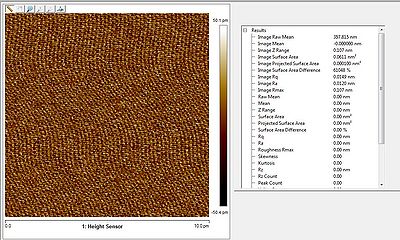
System noise
Noise on sample: scan size 0.1nm
we started with 1my scan size to optimize the scan.
2.43Hz
256 lines
Z range at 2my to get sub nanometer resolution in Z
Rq: 54,5pm (plade vibrator koerte udenfor)
Rq: 23pm uden vibrator koerende + ro og med aaben hood.
Rq:71pm uden vibrator koerende + ro og med lukket hood

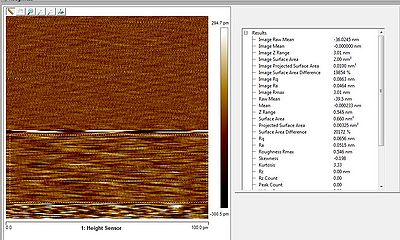
Roughness
HAR: 200nm wide 400nm deep
HAR: 2µm wide 6µm deep
Graphene KPFM measurement
![]()
![]()
Height image: The graphene and structuring in graphene is not visible
Potential image: Potential difference between grapheme and non-graphene is visible
Phase: Phase imaging maps the phase lag between the periodic signal driving the cantilever and the oscillations of the cantilever. Changes in phase lag often indicate changes in the properties of the sample surface. Here the structuring in the graphene is very clear
AFM Icon-Pt 2: Acceptance test
Noise tests
Sensor noise
Tapping ]mode, OTESPA-R3 probe used.
First we made a false engage (scanning in air):
Turn off gain 0 0
Z range 0.2my
Scan size 0.01nm
Roughness: Rq 28 pm (specs 35pm)
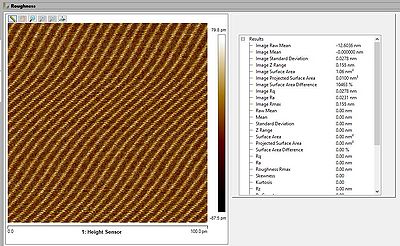
System noise
Noise on sample: scan size 0.1nm
we started with 1my scan size to optimize the scan.
2.43Hz
256 lines
Z range at 2my to get sub nanometer resolution in Z
Rq: 28 pm
Demonstrating roughness measurements on silicon
ScanAsyst with ScanAsyst-air
- CL on
- 512x512
- 0dg
- ScanAsyst noise threshold: 1
- PeakForce amplitide 300 nm
- Peak force frequency: 2 Hz
- Rq: 0.247 nm
ScanAsyst with ScanAsyst-air
- CL off
- 512x512
- 0dg
- ScanAsyst noise threshold: 0.2
- PeakForce amplitide 300 nm
- Peak force frequency: 2 Hz
- Rq: 0.235 nm
ScanAsyst with TAP150A
- CL on
- 512x512
- 0dg
- ScanAsyst noise threshold: 1
- PeakForce amplitude 75 nm (was set as standard from the probe settings)
- Peak force frequency: 2 Hz
- Rq: 0.238/0.250 nm
Tapping mode with TAP150A
- CL on
- 512x512
- 0dg
- Rq: 0.214 nm
Tapping mode with RFESP-75
- CL on
- 512x512
- 0dg
- Rq: 0.224 nm
Step measurement: Resist on silicon oxide
SIO2ICP_30 (Si-SiO2-Resist)
- When scanning long lines and trenches scan 90 degrees to the probe and 90 degrees to the lines.
- During acceptance:
- Tapping mode: 3 µm structures (middle): 1.587µm
- Tapping mode: 3µm structures (edge): 1.541µm
- Peak Force tapping 3µm structures (edge) average: 1.497µm (tapping mode probe)
- Peak Force tapping with ScanAsyst probe: 1.509µm
SEM images showed about 1.55µm – so it seems like ScanAsyst is pressing a little down in the resist compared with the SiO2 giving a too small height difference. Therefor When scanning steps with difference materials, when one of the materials is soft and you need to know the height difference, then it seems to be best to use tapping mode. We did not save the images. Therefor I remeasured a few days later:
Tapping mode with TAP150A
- CL on
- 256x32
- 0dg
- Step height: 1545/1532 nm
ScanAsyst with TAP150A
- CL on
- 256x32
- 0dg
- ScanAsyst noise threshold: 1
- PeakForce amplitide 75 nm (was set as standard from the probe settings)
- Peak force frequency: 2 Hz
- Step height: 1537 nm
ScanAsyst with ScanAsyst-air
- CL on
- 256x32
- 0dg
- ScanAsyst noise threshold: 1
- PeakForce amplitide 150 nm (I had to increase it from the 75 nm)
- Peak force frequency: 2 Hz
- Step height: 1545 nm
Tapping mode with RFESP-75
- CL on
- 256*32
- 0dg
- Step height: 1525 nm
High Aspect ratio sample
High aspect ratio samples (e.g. 100 nm wide trenches 300 nm deep and 2 µm wide trenches 6µm deep). The probes for this: FIB6-400A. This was done and work spaces were created but no images was saved.

